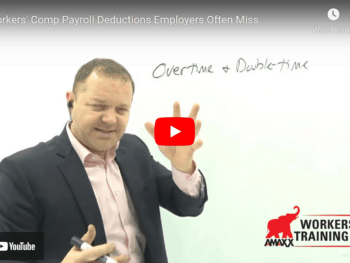While implementing injury management best practices in workers’ compensation is the most effective way to reduce costs and improve injured worker outcomes significantly, the only challenge is tangible results from improvements takes time. Self-insured or high-deductible programs can see tangible results in a matter of months, but an employer in a guaranteed cost program can sometimes wait years to see results in an improved experience mod and lower premium.
The oversimplified basic formula for calculating the total cost of workers’ compensation is:
Payroll x Rate x Experience Modification Factor x Adjustments = Premium
Premium + Claim Costs (in a loss-sensitive plan) = Total Cost of Workers’ Compensation
Double-check to make sure you Job Classification Codes are Accurate
Job codes are a huge component of the premium you pay for workers’ compensation. Therefore, it’s critical codes be applied correctly. The reality of our fast-paced world is businesses change constantly. As a business evolves, the type of worker needed changes to fit the new business model, and as the type of worker changes, so do the job codes. Save your business premium dollars by reviewing your job codes periodically – whether the business has changed or not. Either way, you save money!
Click Link to Access Free PDF Download
“Workers’ Comp Claims Review Checklist: 9 Must-Have, Serious-Impact Elements”
Where does an employer find these job codes?
Most states have adopted a job classification system devised by the National Council on Compensation Insurance (NCCI), consisting of 600+ job codes. Since workers’ compensation is a state-driven system, applying the correct codes is not always an easy task. A few states have adopted the NCCI classifications system, but have unique classifications for certain workforce exposures. Other states have adopted their own classification systems. To make this even more complicated, NCCI doesn’t publish its complete list of codes on the Internet. You can buy the list from NCCI, but it is not practical for most businesses to do so.
Why are there so many job codes?
Jobs having low-risk exposure carry a low rate; high-risk jobs carry a higher rate. As an example, the rate for clerical workers is much lower than workers who handle chemicals because the potential workplace injury exposure associated with the two jobs is quite different. No matter what system your state uses, each job code has an associated rate used to calculate your worker’s compensation premium. A business may also have multiple classifications. A chemical manufacturer is further classified by the types of chemicals it produces. Once the business classification is properly identified, classifications drill down to the type of work performed (such as chemical material handler, clerical, sales, etc.).
So, where do you turn?
Your insurance carrier and broker have a list of job codes by state and will work with you to identify the correct codes for your business. As this review may save premium dollars for you, it also benefits the carrier by ensuring the risk they cover is a known risk. For corporations with multiple sites in several states and thousands of employees, reviewing job codes involves several stakeholders and takes time, perhaps many months. The insurance risk manager, carrier, and broker should be at the table. You also want to invite division representatives who are well acquainted with site operations and the work performed there. You may want to include a payroll representative who actually assigns job codes to individuals within your payroll system. Once the stakeholders are identified, review the operations and their jobs systematically. As a possible approach, first identify those job titles that can be grouped into large classifications, such as clerical and sales, which are most easily assigned to a job code. Then, move into the more specialized areas, such as the chemical material handler mentioned above.
Repeat! Repeat!
Enough cannot be said of the importance of reviewing your job codes periodically, particularly if your operation has changed in recent years. A thorough review ensures all codes are correctly applied for all workers and will likely result in a lower workers’ comp premium for the company.

Contact: mstack@reduceyourworkerscomp.com.
Workers’ Comp Roundup Blog: http://blog.reduceyourworkerscomp.com/
©2023 Amaxx LLC. All rights reserved under International Copyright Law.
Do not use this information without independent verification. All state laws vary. You should consult with your insurance broker, attorney, or qualified professional.















